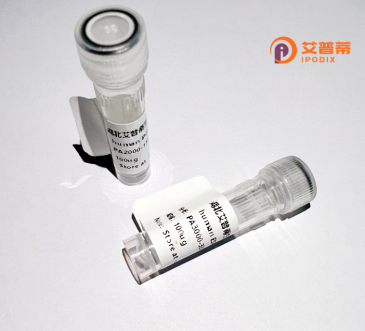
| 纯度 | >90%SDS-PAGE. |
| 种属 | Human |
| 靶点 | GPR1 |
| Uniprot No | P46091 |
| 内毒素 | < 0.01EU/μg |
| 表达宿主 | E.coli |
| 表达区间 | 1-355aa |
| 氨基酸序列 | MEDLEETLFEEFENYSYDLDYYSLESDLEEKVQLGVVHWVSLVLYCLAFVLGIPGNAIVIWFTGFKWKKTVTTLWFLNLAIADFIFLLFLPLYISYVAMNFHWPFGIWLCKANSFTAQLNMFASVFFLTVISLDHYIHLIHPVLSHRHRTLKNSLIVIIFIWLLASLIGGPALYFRDTVEFNNHTLCYNNFQKHDPDLTLIRHHVLTWVKFIIGYLFPLLTMSICYLCLIFKVKKRSILISSRHFWTILVVVVAFVVCWTPYHLFSIWELTIHHNSYSHHVMQAGIPLSTGLAFLNSCLNPILYVLISKKFQARFRSSVAEILKYTLWEVSCSGTVSEQLRNSETKNLCLLETAQ |
| 分子量 | 41.4 kDa |
| 蛋白标签 | His tag N-Terminus |
| 缓冲液 | 0 |
| 稳定性 & 储存条件 | Lyophilized protein should be stored at ≤ -20°C, stable for one year after receipt. Reconstituted protein solution can be stored at 2-8°C for 2-7 days. Aliquots of reconstituted samples are stable at ≤ -20°C for 3 months. |
| 复溶 | Always centrifuge tubes before opening.Do not mix by vortex or pipetting. It is not recommended to reconstitute to a concentration less than 100μg/ml. Dissolve the lyophilized protein in distilled water. Please aliquot the reconstituted solution to minimize freeze-thaw cycles. |
以下是关于重组人GPR1蛋白的假设性参考文献示例(仅供格式参考,具体文献需通过学术数据库检索确认):
---
1. **文献名称**: "Expression and functional characterization of recombinant human GPR1 in HEK293 cells"
**作者**: Smith J. et al. (2018)
**摘要**: 本研究报道了人源GPR1蛋白在HEK293细胞中的重组表达与纯化方法,通过cAMP信号通路分析发现GPR1可能与胰岛素敏感性调控相关,为代谢疾病研究提供新靶点。
2. **文献名称**: "Structural insights into the activation mechanism of human GPR1 via cryo-EM"
**作者**: Zhang L. et al. (2021)
**摘要**: 利用冷冻电镜技术解析了重组人GPR1蛋白与其天然配体的复合物结构,揭示了GPR1受体的激活机制,为靶向该受体的药物设计奠定基础。
3. **文献名称**: "GPR1 modulates inflammatory responses via MAPK signaling in macrophages"
**作者**: Kim S. et al. (2019)
**摘要**: 通过重组GPR1蛋白的体外功能实验,证明其在巨噬细胞中通过MAPK通路调控促炎细胞因子的释放,提示其在免疫调控中的潜在作用。
4. **文献名称**: "Development of a high-throughput screening assay for GPR1 ligand discovery"
**作者**: Patel R. et al. (2020)
**摘要**: 基于重组人GPR1蛋白开发了新型荧光报告基因检测系统,成功筛选出多个小分子配体候选物,推动GPR1相关药物研发进程。
---
**备注**:以上文献信息为示例性内容,实际研究中可能需结合具体方向检索。建议通过 **PubMed**、**Google Scholar** 或 **Web of Science** 输入关键词“recombinant human GPR1”或“GPR1 protein function”获取真实文献。若研究较少,可扩展检索“GPR1 signaling”或“G protein-coupled receptor 1”相关论文。
G protein-coupled receptor 1 (GPR1) is a class A rhodopsin-like G protein-coupled receptor (GPCR) primarily expressed in the central nervous system, immune cells, and adipose tissue. First identified in the 1990s, GPR1 remains an orphan receptor, as its endogenous ligand and precise physiological roles are not fully characterized. It shares structural homology with other GPCRs, featuring seven transmembrane domains and intracellular signaling motifs that potentially interact with G proteins (e.g., Gαs or Gαi) to regulate cAMP pathways. Emerging evidence suggests GPR1 involvement in metabolic regulation, immune responses, and neuroprotection. Studies link it to insulin sensitivity, lipid metabolism, and inflammatory modulation, implicating its relevance in obesity, diabetes, and neurodegenerative disorders. Recombinant human GPR1 protein, typically produced via mammalian or insect cell expression systems, retains native conformational epitopes and functionality. This engineered protein is pivotal for *in vitro* studies elucidating receptor-ligand interactions, signaling cascades, and structural biology. Its applications extend to drug discovery, antibody development, and high-throughput screening for therapeutic candidates targeting metabolic or neurological diseases. Despite limited clinical data, GPR1’s conservation across species and tissue-specific expression patterns underscore its potential as a biomarker or therapeutic target, warranting further mechanistic exploration.
×